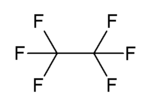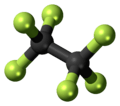Hexafluoroethane
Hexafluoroethane is a fluorocarbon counterpart to the hydrocarbon ethane. It is a non-flammable gas negligibly soluble in water and slightly soluble in alcohol.
| |||
| Names | |||
|---|---|---|---|
| IUPAC name
Hexafluoroethane | |||
| Other names
Carbon hexafluoride, 1,1,1,2,2,2-Hexafluoroethane, Perfluoroethane, Ethforane, Halocarbon 116, PFC-116, CFC-116, R-116, Arcton 116, Halon 2600, UN 2193 | |||
| Identifiers | |||
3D model (JSmol) |
|||
| ChEBI | |||
| ChEMBL | |||
| ChemSpider | |||
| ECHA InfoCard | 100.000.855 | ||
| EC Number |
| ||
PubChem CID |
|||
| RTECS number |
| ||
| UNII | |||
CompTox Dashboard (EPA) |
|||
| |||
| |||
| Properties | |||
| C2F6 | |||
| Molar mass | 138.01 g.mol−1 | ||
| Appearance | Colorless odorless gas | ||
| Density | 5.734 kg.m−3 at 24 °C | ||
| Melting point | −100.6 °C (−149.1 °F; 172.6 K) | ||
| Boiling point | −78.2 °C (−108.8 °F; 195.0 K) | ||
| 0.0015% | |||
| log P | 2 | ||
Henry's law constant (kH) |
0.000058 mol.kg−1.bar−1 | ||
| Hazards | |||
| Safety data sheet | See: data page | ||
| NFPA 704 (fire diamond) | |||
| Flash point | Non-flammable | ||
| Supplementary data page | |||
| Refractive index (n), Dielectric constant (εr), etc. | |||
Thermodynamic data |
Phase behaviour solid–liquid–gas | ||
| UV, IR, NMR, MS | |||
Except where otherwise noted, data are given for materials in their standard state (at 25 °C [77 °F], 100 kPa). | |||
| Infobox references | |||
Physical properties
Hexafluoroethane's solid phase has two polymorphs. In the scientific literature, different phase transition temperatures have been stated. The latest works assign it at 103 K (−170 °C). Below 103 K it has a slightly disordered structure, and over the transition point, it has a body centered cubic structure.[1] The critical point is at 19.89 °C (293.04 K) and 30.39 bar.[2]
Table of densities:
| State, temperature | Density (kg.m−3) |
|---|---|
| liquid, −78.2 °C | 16.08 |
| gas, −78.2 °C | 8.86 |
| gas, 15 °C | 5.84 |
| gas, 20.1 °C | 5.716 |
| gas, 24 °C | 5.734 |
Vapor density is 4.823 (air = 1), specific gravity at 21 °C is 4.773 (air = 1) and specific volume at 21 °C is 0.1748 m3/kg.
Uses
Hexafluoroethane is used as a versatile etchant in semiconductor manufacturing. It can be used for selective etching of metal silicides and oxides versus their metal substrates and also for etching of silicon dioxide over silicon. The primary aluminium and the semiconductor manufacturing industries are the major emitters of hexafluoroethane.
Together with trifluoromethane it is used in refrigerants R508A (61%) and R508B (54%).
Environmental effects
Due to the high energy of C-F bonds, it is very inert and thus acts as an extremely stable greenhouse gas, with an atmospheric lifetime of 10,000 years (other sources: 500 years)[3] and a global warming potential (GWP) of 9200. A calculated atmospheric lifetime range of 500 to 10,000 years has been reported.[3] Atmospheric concentration of tetrafluoroethane is 3 pptv (increase by 3 pptv since 1750[4]). However, it has a strong absorption potential in the infrared part of the spectrum. Radiative forcing is 0.001 W/m2. Its ozone depletion potential (ODP) is 0.
Hexafluoroethane is listed in IPCC list of greenhouse gases.
Main industrial emissions of hexafluoroethane besides tetrafluoromethane are produced during production of aluminium using Hall-Héroult process.
Health risks
Due to its high relative density, it gathers in low-lying areas, and at high concentrations it can cause asphyxiation. Other health effects are similar to tetrafluoromethane.
See also
- Fluorocarbon, Perfluorocarbon
- Tetrafluoromethane
- Octafluoropropane
- Ethane
- Tetrafluoroethene
- Hexachloroethane
References
- Zeng, S.X.; Simmons, R.O.; Timms, D.N.; Evans, A.C. (1999). "Dynamics and structure of solid hexafluoroethane". Journal of Chemical Physics. 110 (3): 1650–61. Bibcode:1999JChPh.110.1650Z. doi:10.1063/1.477806.
- Helmut Schan: Handbuch der reinsten Gase. Springer, 2005, ISBN 978-3-540-23215-5, S. 307.
- "Perfluoroethane CASRN: 76-16-4". TOXNET Toxicology Data Network. National Library of Medicine. 2016-10-25.
- "Climate Change 2001: The Scientific Basis". Archived from the original on 2007-06-15. Retrieved 2007-06-02.
- Bozin SE, et al. (1968). "Growth of ionization currents in carbon tetrafluoride and hexafluoroethane". J. Phys. D: Appl. Phys. 1 (3): 327–334. Bibcode:1968JPhD....1..327B. doi:10.1088/0022-3727/1/3/309.
External links
- Purification process of hexafluoroethane
- Protocol for measurement of tetrafluoromethane and hexafluoroethane from primary aluminium production
- De Maré, G.R.; Panchenko, Yu. N. (March 2006). "Ab initio vibrational analysis of hexafluoroethane C2F6". Journal of Structural Chemistry. 47 (2): 232–240. doi:10.1007/s10947-006-0291-y.
- Protocol for Measurement of Tetrafluoromethane (CF
4) and Hexafluoroethane (C
2F
6) Emissions from Primary Aluminum Production - Thermochemistry data table at chemnet.ru


